11 Best Freshdesk Alternatives of 2025

Table of contents
Freshdesk has earned its stripes as a customer support solution by providing a user-friendly interface and a great set of features that helps businesses efficiently handle customer queries. However, the quest for Freshdesk alternatives indicates a keen interest among businesses to explore other tools. These alternatives often present distinct advantages capable of addressing the gaps users encounter with Freshdesk.
This beckons a closer look at alternatives to Freshdesk that address its downsides while introducing unique advantages of their own.
Table of Contents
- Why Choose A Freshdesk Alternative
- Top 11 Alternatives to Freshdesk
- Key Features to Look for in a Freshdesk Alternative
- How to Choose the Best Freshdesk Alternative
- Upgrade to a better solution
Why Choose A Freshdesk Alternative
There are circumstances where companies might find Freshdesk not aligning perfectly with their specific needs. Whether it’s due to budget constraints, the need for specialized functionalities, user experience preferences, scalability concerns, integration requirements, or the level of vendor support, businesses often explore alternatives that better suit their unique operational requirements.
Understanding where Freshdesk may not meet certain criteria can guide businesses in making a more informed decision towards a solution that resonates more closely with their specific needs and goals.
- Pricing Structure: Freshdesk’s advanced features, essential for larger businesses or complex needs, can be costly, particularly when compared to more affordable alternatives.
- One of the main reasons Freshdesk’s advanced features can be costly is because they require additional development and maintenance. For example, the Freddy AI feature, which uses artificial intelligence to help agents resolve tickets more quickly, requires significant investment in research and development.
- Additionally, Freshdesk’s enterprise-level plans include features such as custom portals and integrations, which also require additional development resources.
- Another factor that contributes to the cost of Freshdesk’s advanced features is the need for specialized support. Businesses that use these features often require more hands-on support from Freshdesk in order to configure and use them effectively. This can lead to higher support costs, which are typically passed on to the customer.
- Finally, the cost of Freshdesk’s advanced features can also be affected by the number of users in a business. Businesses with a large number of users may need to purchase more expensive plans in order to access all of the features they need. Additionally, some advanced features, such as the ability to create custom fields and workflows, may only be available on higher-priced plans.
- One of the main reasons Freshdesk’s advanced features can be costly is because they require additional development and maintenance. For example, the Freddy AI feature, which uses artificial intelligence to help agents resolve tickets more quickly, requires significant investment in research and development.
- Complexity for Small Teams: Smaller teams or businesses might find Freshdesk’s extensive feature set overwhelming, leading to a steeper learning curve. The abundance of features can be overwhelming, making it difficult for users to navigate and identify the tools they need effectively.
This can lead to extended onboarding periods, reduced productivity, and increased frustration among team members. Several factors contribute to the steeper learning curve for smaller teams using Freshdesk’s extensive feature set:- Feature complexity: Freshdesk’s advanced features, such as Freddy AI and custom portals, require a deeper understanding of their functionalities and configurations. Smaller teams may not have the resources or expertise to fully grasp these complexities, leading to delays in implementation and utilization.
- Lack of dedicated support: Smaller teams may not have the luxury of dedicated IT staff or support personnel to assist with Freshdesk implementation and usage. This can leave them to troubleshoot issues and resolve technical problems on their own, further extending the learning curve.
- Feature complexity: Freshdesk’s advanced features, such as Freddy AI and custom portals, require a deeper understanding of their functionalities and configurations. Smaller teams may not have the resources or expertise to fully grasp these complexities, leading to delays in implementation and utilization.
- Reporting and Analytics Limitations: While Freshdesk provides reporting and analytics capabilities, businesses with complex data analysis needs may encounter limitations that hinder their ability to extract valuable insights from their support data. These limitations can manifest in various aspects of Freshdesk’s reporting and analytics capabilities:
- Data Granularity: Freshdesk’s reporting tools may not provide the level of granularity required for in-depth analysis. For instance, businesses may need to break down ticket data by specific fields, such as custom fields or unique identifiers, to uncover granular trends and patterns. However, Freshdesk’s reporting options may limit the ability to filter and segment data to this level of detail.
- Data Visualization: Freshdesk’s reporting tools may lack the flexibility to create customized visualizations that effectively communicate complex data relationships. Businesses may need to create interactive dashboards, charts, and graphs that go beyond the standard visualizations offered by Freshdesk to gain a deeper understanding of their support data.
- Real-time analytics: Freshdesk’s reporting tools may not provide real-time insights into support operations. Businesses may need to access live dashboards or data streams to monitor the pulse of their support performance and make timely decisions.
- Integration with external data sources: Freshdesk’s reporting tools may not have seamless integration with external data sources, such as CRM systems or marketing automation platforms. Businesses may need to manually extract and combine data from multiple sources to create comprehensive reports, which can be time-consuming and error-prone.
- Data Granularity: Freshdesk’s reporting tools may not provide the level of granularity required for in-depth analysis. For instance, businesses may need to break down ticket data by specific fields, such as custom fields or unique identifiers, to uncover granular trends and patterns. However, Freshdesk’s reporting options may limit the ability to filter and segment data to this level of detail.
- Customer Support Issues: There are instances where users have reported less than satisfactory experiences with Freshdesk’s customer support, particularly concerning response times and resolution effectiveness.
These drawbacks can lead businesses to consider alternatives that better align with their specific requirements, budget, and operational scale.
Top 11 Alternatives to Freshdesk
Looking at Freshdesk alternatives for 2025, we’re diving into different options to see which ones could match up well with what your business is looking for in customer support.
1. Hiver
An ideal customer service platform should be user-friendly, provide support team-centric features, be universally accessible, scalable, and offer prompt vendor support.
Hiver ticks all these boxes and more. It helps teams assign, track, and collaborate on customer queries, as well as run the most advanced analytics and automation right from Gmail or Outlook (a platform most of us are familiar with). It’s a full-fledged customer support solution that is feature-rich as well as simple.
Ease of Setup:
The setup process for Hiver is remarkably straightforward, largely due to its seamless integration with email clients like Gmail and Outlook. This integration means that users familiar with Gmail or Outlook can adapt to Hiver in about 5 minutes, bypassing the often time-consuming and complex setup processes associated with many other customer support platforms.
This ease of setup is crucial for teams looking to implement a solution quickly and without the need for extensive training or a steep learning curve. By building on an already familiar platform, Hiver reduces the resistance and downtime typically associated with adapting to a new system, allowing teams to focus on customer service without the added burden of learning a new tool.
In-Depth Analytics:
Analytics in Hiver are designed to provide in-depth and meaningful insights into customer service performance. This is particularly significant when compared to Freshdesk’s reporting features, which some users find to provide only a superficial understanding of support quality.
The depth of Hiver’s analytics allows for a more nuanced and comprehensive analysis of customer interactions, helping businesses to identify trends, measure team performance, and make data-driven decisions.
Hiver allows you to analyze your response times at every email level. This means not only can you check your average response time, but you can also dig deeper and analyze this metric by:
1. First response: Time taken to acknowledge your customer’s query
2. Next response: Time taken to respond to your customer’s subsequent reply
3. Periodic response: Time taken to send a follow-up email to your response in case the customer hasn’t replied
This level of detail in reporting is crucial for businesses seeking to continuously improve their customer service and understand the impact of their support efforts on overall customer satisfaction.
Multi-channel support:
To access Freshchat, you’ll either have to purchase the Freshdesk Omnichannel suite (starting at $29) or pay an additional price for Freshchat separately (which starts at $15).
With far more pocket-friendly pricing and a negligible learning curve, in comparison, Hiver helps support teams:
1. Manage tickets seamlessly
2. Resolve Live chat queries,
3. Build and maintain a knowledge base,
4. Handle queries via WhatsApp,
5. Make and receive customer calls (via integration with Aircall)*
…all without leaving the email interface.
*Voice call integration is included under Hiver’s Pro plan (starting at $49). All other omnichannel functionalities listed above are offered in the Lite plan (starting at $19).
Customer Support:
Hiver’s approach to customer support is one of its standout features. Offering uninterrupted, 24×7 support across all its plans, Hiver ensures that users have access to assistance whenever needed. This level of support, highlighted by its rapid response time, contrasts sharply with some of the frustrations expressed by Freshdesk users, who occasionally report unreliable and slow support.
The ability to receive timely and effective help not only enhances the user experience but also ensures that any issues impacting customer service can be swiftly addressed, thus maintaining a high level of service continuity and customer satisfaction.
Hiver offers four pricing tiers for it’s customers:
- Forever free plan
- Lite plan: $19/user/month
- Pro plan: $49/user/month
- Elite plan: $79/user/month
2. Zendesk
Zendesk is a customer service software company that provides a cloud-based suite of tools designed to improve customer support and enhance customer engagement. Their main product is a help desk platform that enables businesses to manage customer interactions across various channels like email, phone, chat, and social media.
Zendesk’s platform typically includes features like ticketing systems, knowledge bases, and community forums, which are integrated to streamline support processes and provide a unified view of customer interactions.
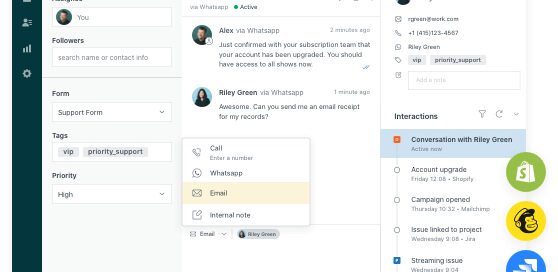
The software is known for its user-friendly interface, scalability, and flexibility, catering to businesses of all sizes across different industries. It also offers analytics and reporting capabilities, allowing companies to track performance metrics and gain insights into customer satisfaction and support efficiency.
Pros of Zendesk:
- Robust Multichannel Support: Zendesk provides seamless support across email, web, social media, and phone, all from a single dashboard.
- Advanced Automation and AI: Zendesk’s Answer Bot uses machine learning to help answer customer queries quickly.
- Extensive Customization Options: It offers a multitude of apps and integrations in its marketplace, allowing for a highly tailored user experience.
- Scalability: It’s designed to grow with your business, from basic tools for startups to advanced solutions for large enterprises.
- Strong Reporting and Analytics: Zendesk has a comprehensive suite of analytics tools that provide in-depth insights into customer satisfaction and agent performance.
Cons of Zendesk:
- Learning Curve: New users may find Zendesk’s wide array of features overwhelming, leading to a steeper learning curve.
- Price Point: While offering an extensive feature set, Zendesk can be more expensive than Freshdesk, especially when considering add-ons and premium features.
- Complexity: Some users report that the platform can be complex to navigate, requiring more time to train staff effectively.
- Customization Requires Technical Know-How: To fully exploit the customization options, a business might need access to technical resources.
Pricing:
The pricing for the Zendesk Suite package is structured into different tiers, offering a range of features that accommodate businesses from small to large enterprises. Below are the pricing details for each tier, both on an annual and monthly subscription basis:
- Suite Team: This entry-level plan is aimed at small teams and includes basic features for omnichannel support. The annual subscription cost is $55 per agent per month, while the monthly subscription is $69 per agent per month.
- Suite Growth: Designed for handling higher support volumes, this plan includes features like conversation routing based on skills and a self-service portal. The annual subscription is priced at $89 per agent per month, and the monthly subscription comes in at $115 per agent per month.
- Suite Professional: This plan offers features for growing teams and better collaboration and analytics. For an annual subscription, the cost is $115 per agent per month. If you opt for a monthly subscription, the cost is $149 per agent per month.
- Suite Enterprise: Targeted at delivering personalized customer experiences at scale, this tier includes features like custom permissions and agent workspaces. The annual subscription rate is $169 per agent per month, while the monthly subscription is $219 per agent per month.
Zendesk costs 2x more than Hiver
Is Zendesk better than Freshdesk?
- Ticketing and Support: Both Freshdesk and Zendesk provide robust ticketing systems and support multiple channels for customer interactions.
- Automation and AI: Zendesk offers more advanced automation and AI capabilities than Freshdesk.
- User Interface and Pricing: Freshdesk has a more straightforward interface and competitive pricing, making it appealing to smaller businesses or those with simpler requirements.
- Scalability and Integration: Larger businesses or those in need of deep customization and extensive integration might prefer Zendesk for its scalability and comprehensive integration ecosystem, even though it may come at a higher cost.
3. Help Scout
Help Scout differentiates itself in the customer service software market with its focus on simplicity and customer-centric features. It’s designed for businesses that prioritize straightforward support tools and a personal touch in customer interactions. Let’s explore what Help Scout offers and how it sizes up to Freshdesk.
Pros of Help Scout:
- User-Friendly Interface: Known for its clean and intuitive design, making it easy for teams to adopt and use.
- Customer-Centric Features: Offers a range of tools designed to make customer interactions more personal and effective.
- Collaboration Tools: Advanced collaboration options for teams to work together seamlessly.
- Focused Functionality: Instead of a wide array of features, Help Scout focuses on doing a few things very well.
Cons of Help Scout:
- Limited Integrations: While it offers essential integrations, it may not have as extensive a marketplace as Freshdesk.
- No Native Social Media Support: Unlike Freshdesk, Help Scout does not offer built-in social media support.
- Feature Limitations: Some advanced features and automations available in Freshdesk are not present in Help Scout.
Pricing:
Help Scout’s pricing is straightforward and tiered based on the features and scale:
- Standard: $20 per user per month, suited for small to midsize teams (billed annually).
- Plus: $40 per user per month, offering advanced features for larger teams (billed annually).
- Pro: $65 per user per month, tailored for large teams needing advanced security and service (billed annually).
Is Help Scout better than Freshdesk?
- Feature Set: Freshdesk offers a wide range of features suitable for businesses of various sizes, with a strong emphasis on automation and integration.
- Simplicity and User Experience: Help Scout focuses on simplicity, providing an uncomplicated yet effective platform ideal for teams prioritizing ease of use and personal customer interactions.
- Pricing and Approach: Help Scout’s straightforward pricing and customer-centric approach makes it an attractive option for businesses seeking to offer exceptional support.
- Best Fit: While Freshdesk caters to those needing a comprehensive feature set, Help Scout is more suited for businesses looking for a simpler, more focused customer support experience.
Save over 40% by choosing Hiver over Help Scout
4. Zoho Desk
Zoho Desk is a customer support software that offers a range of tools for managing customer interactions. It is part of the broader Zoho suite of business applications and is known for its capabilities in ticketing, automation, and multi-channel support.
Zoho Desk caters to a diverse clientele, from small businesses to larger enterprises, offering different levels of functionality to suit various operational scales.
Pros of Zoho Desk:
- Extensive Integration Options: Zoho Desk integrates well with other Zoho products and a variety of third-party applications.
- Customization: It offers a high degree of customization to fit various business processes.
- AI Capabilities: With Zia, Zoho’s AI assistant, businesses can automate routine tasks and gain insights from customer data.
- Multi-Channel Support: Supports a range of communication channels, including email, social media, and live chat.
Cons of Zoho Desk:
- Complexity: The extensive features and customization options can be overwhelming for smaller teams or businesses new to such software.
- Learning Curve: Due to its broad capabilities, it may require more time to fully understand and utilize all its features.
- Integration Reliance: While integration is a strength, businesses not using other Zoho products may not benefit as much from Zoho Desk.
Pricing:
Here’s a breakdown of Zoho Desk’s pricing:
- Zoho Desk Express: $7 per user per month (billed annually) or $9 (monthly billing).
- Standard: $14 per agent per month (billed annually) or $20 (monthly billing).
- Professional: $23 per agent per month (billed annually) or $35 (monthly billing).
- Enterprise: $40 per agent per month (billed annually) or $50 (monthly billing).
Is Zoho Desk better than Freshdesk?
- Ticketing System and Support Channels: Both Zoho Desk and Freshdesk provide robust ticketing systems and support multiple channels for customer interaction.
- Integration Capabilities: Zoho Desk excels with deeper integration capabilities, particularly within the Zoho ecosystem, offering enhanced connectivity with other business tools.
- AI Assistance: Zoho Desk features an advanced AI assistant, Zia, which adds a layer of sophistication to its service.
- User-Friendliness: Freshdesk may be more suitable for businesses looking for a simpler and more straightforward customer service tool.
- Business Needs: The choice between Zoho Desk and Freshdesk often depends on the specific requirements of a business, especially regarding integration needs and desired customization levels.
Discover the best Zoho Desk Alternatives
5. Salesforce Service Cloud
Salesforce Service Cloud is a robust customer relationship management (CRM) platform known for its extensive features and scalability. It caters primarily to larger enterprises and organizations looking for a comprehensive solution to manage customer service, sales, and marketing. With its advanced AI capabilities and wide range of integrations, Salesforce Service Cloud is a popular choice for businesses seeking a highly customizable and scalable service platform.
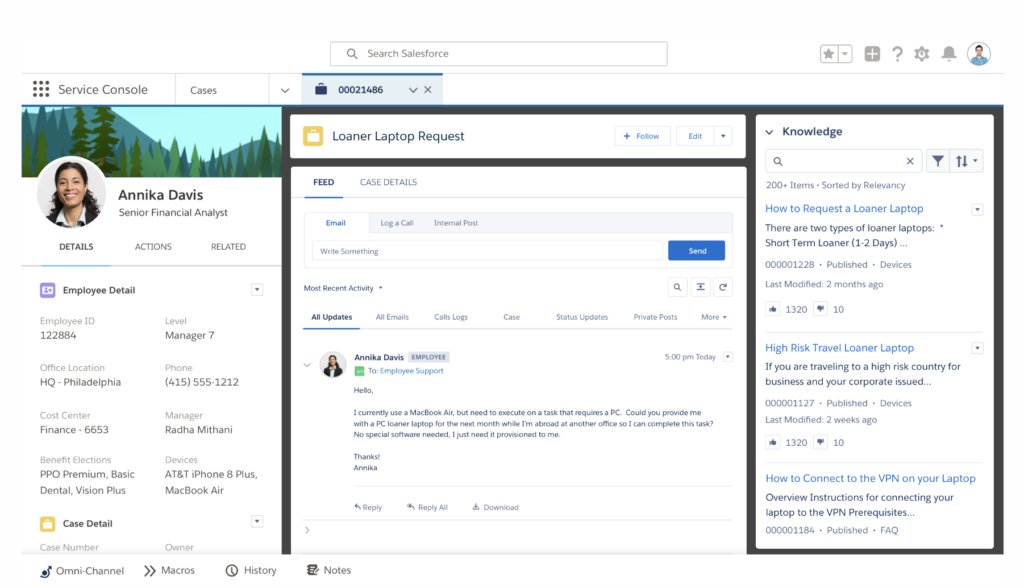
Pros of Salesforce Service Cloud:
- Advanced AI and Analytics: Incorporates AI-driven insights and analytics to enhance customer service.
- Highly Customizable: Offers extensive customization options to fit the specific needs of businesses.
- Scalability: Well-suited for large enterprises due to its ability to handle high volumes of customer interactions.
- Comprehensive Integration: Seamlessly integrates with other Salesforce products and a wide range of third-party applications.
Cons of Salesforce Service Cloud:
- Complexity: Its extensive features can be overwhelming and may require a significant time investment to learn.
- Higher Cost: Generally more expensive than other alternatives, making it less accessible for small businesses.
- Resource Intensive: Requires more resources and technical know-how for implementation and management.
Pricing:
Salesforce Service Cloud offers several pricing tiers, billed annually:
- Starter: $25 per user per month.
- Professional: $80 per user per month.
- Enterprise: $165 per user per month.
- Unlimited: $330 per user per month.
- Unlimited+: $500 per user per month.
Is Salesforce Service Cloud better than Freshdesk?
- User-Friendliness and Accessibility: Freshdesk is more accessible and user-friendly, particularly for small to medium-sized businesses. It offers a simpler interface, making it easier to navigate.
- Pricing: Freshdesk is less costly than Salesforce Service Cloud, appealing more to budget-conscious businesses.
- Customization and Scalability: Salesforce Service Cloud provides extensive customization and scalability, suitable for larger enterprises or businesses with complex integration needs.
- Ideal Use Case: Freshdesk is best for businesses seeking an efficient and straightforward customer service tool, while Salesforce Service Cloud is better for those requiring in-depth customization and higher scalability, despite its greater complexity and cost.
6. Kayako
Kayako is a customer support platform that emphasizes the integration of multiple service channels into a unified system, catering to businesses of various sizes. Its design focuses on user accessibility and simplifying customer support processes, with a user-friendly interface that consolidates communications from emails, chats, and social media.
Key features include customizable workflows, allowing businesses to tailor the platform to their specific needs, and comprehensive reporting tools for performance analysis. Overall, Kayako aims to provide a straightforward, integrated solution for managing customer interactions efficiently.
Pros of Kayako:
- Integrated Support Channels: Offers a unified platform for managing email, live chat, and social media interactions.
- User-Friendly Interface: Known for its intuitive design, making it easy for support teams to navigate.
- Customizable Workflows: Provides flexibility in setting up workflows to match specific business processes.
- Robust Reporting: Features comprehensive reporting tools to track and analyze customer support performance.
Cons of Kayako:
- Limited Integrations: While it offers essential integrations, it may not be as extensive as some of its competitors.
- Feature Set: May lack some of the more advanced features found in other customer support platforms.
- Scalability: While it suits small to medium-sized businesses, larger enterprises might require more extensive features.
Pricing:
- Inbox: $15 per agent per month – a shared email, chat, and social inbox for small teams.
- Growth: $30 per agent per month – customer service software for growing teams.
- Scale: $60 per agent per month – customer service software for larger teams and businesses.
- Enterprise: Starts at $100 per agent – a custom approach for larger companies.
Is Kayako better than Freshdesk?
- Feature Set: Both Kayako and Freshdesk offer robust customer service tools. However, Freshdesk provides a broader range of integrations and a more extensive set of features.
- User Experience: While Freshdesk is renowned for its simplicity and ease of use, Kayako’s strength lies in its unified inbox, which simplifies communication.
- Customization: Freshdesk offers more flexibility in ticketing and automation, particularly at its lower pricing tiers.
- Pricing: Freshdesk is generally more affordable and favored by smaller businesses, while Kayako’s pricing structure and features appeal to those prioritizing streamlined communication channels.
- Best Fit: Choosing between Kayako and Freshdesk depends on specific business needs, especially regarding the depth of features and budget considerations. Freshdesk is ideal for varied businesses seeking a comprehensive tool, while Kayako is suitable for those focusing on efficient communication management.
Discover the best Kayako Alternatives
7. Hubspot Service Hub
HubSpot Service Hub offers a customer service solution that integrates with HubSpot’s CRM and marketing tools, aiming to provide a cohesive platform for customer engagement and support. It emphasizes a unified view of customer interactions and personalizes support by integrating various business functions.
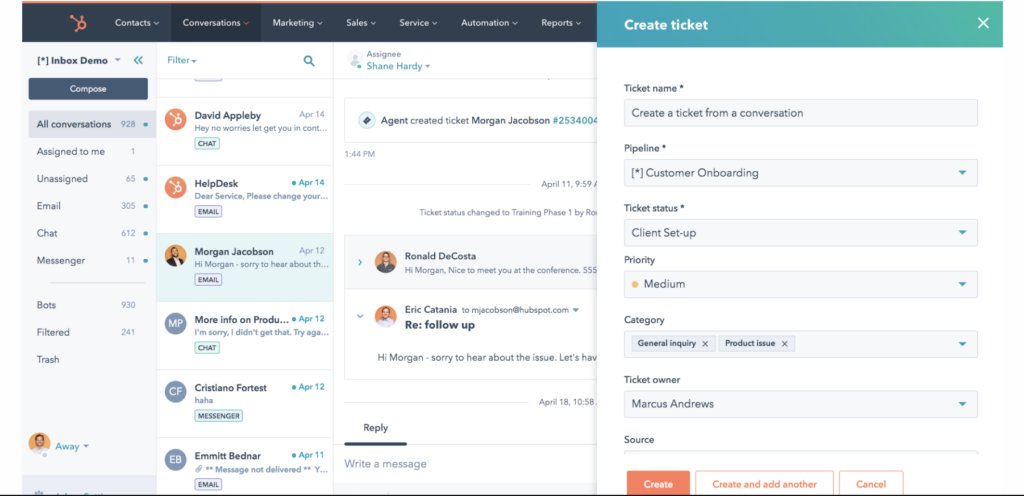
The platform features a user-friendly interface and includes features like ticketing systems, live chat, and knowledge bases. It is designed for businesses looking to consolidate their customer service operations and is characterized by its integration with other HubSpot offerings.
Pros:
- Integrated CRM: Seamless integration with HubSpot’s CRM allows for a unified view of customer interactions across sales, marketing, and service.
- Automation and Self-service Options: Offers tools like chatbots and knowledge bases to enable customers to find answers quickly.
- Customizable Support Tools: Highly customizable support ticketing system to cater to various business needs.
- Reporting and Analytics: Advanced analytics provide insights into customer satisfaction and service efficiency.
- User-friendly Interface: Known for its intuitive design, making it easy for teams to adopt and use.
Cons:
- Pricing: Can be on the higher side, especially for small businesses or startups.
- Learning Curve: The extensive features can be overwhelming for new users, requiring time to master.
- Integration Dependencies: To get the most out of HubSpot Service Hub, integration with other HubSpot tools is often necessary, potentially increasing costs.
Pricing:
HubSpot Service Hub offers several pricing tiers:
Intercom’s pricing varies based on the usage and features needed:
- Free: Basic features with limited scope.
- Starter: Starts at $45 per month.
- Professional: Starts at $360 per month, offering more advanced features.
- Enterprise: Starts at $1,200 per month, providing the most comprehensive set of tools and analytics.
Is Hubspot better than Freshdesk?
- Feature Set: While both offer a comprehensive set of customer service tools, HubSpot Service Hub’s integration with its CRM gives it an edge in managing customer relationships.
- User Experience: HubSpot is often praised for its user-friendly interface, while Freshdesk is known for its simplicity and ease of use.
- Customization: Freshdesk offers more flexibility in ticketing and automation at lower pricing tiers compared to HubSpot.
- Pricing: Freshdesk is generally more affordable, making it a popular choice for smaller businesses, whereas HubSpot’s pricing can be higher, but it offers more in terms of CRM integration and advanced analytics.
- Best Fit: HubSpot Service Hub might be more suitable for businesses already using other HubSpot tools and needing deep CRM integration, whereas Freshdesk suits businesses looking for a straightforward, cost-effective customer support tool.
8. Intercom
Intercom is a customer communication platform known for its real-time messaging and engagement capabilities. It stands out in the market for its focus on facilitating direct and instant interactions between businesses and customers.
Central to its offerings is a suite of tools that include live chat, targeted messaging, and an advanced chatbot called the “Resolution Bot.” This bot, leveraging artificial intelligence, is designed to automate responses and handle common customer queries efficiently, enhancing the overall support experience.
Intercom’s approach combines these innovative technologies with a deep focus on personalization, making use of customer data to tailor interactions. The platform caters to a wide range of businesses, adaptable to various scales and operational needs, from small startups to large enterprises.
Pros:
- Real-time Communication: Specializes in live chat capabilities, offering immediate interaction with customers.
- Personalized Customer Engagement: Uses customer data to personalize interactions, enhancing customer experience.
- Versatile Messaging Tools: Provides a range of messaging options, including targeted in-app messages and push notifications.
- Automation and Bots: Provides automated messaging and chatbots to handle common queries efficiently.
- Integration Capabilities: Offers robust integration with other business tools and software.
Cons:
- Pricing Structure: Can be expensive for small businesses, especially when scaling up.
- Complexity: Some users find the platform somewhat complex due to its extensive features.
- Limited Ticketing System: The focus on messaging means traditional ticketing functionalities may not be as developed as other platforms.
Pricing:
- Starter Plan: Aimed at small businesses, with basic chat and messaging features.
- Growth Plan: Offers more advanced features suitable for growing businesses.
- Pro and Enterprise Plans: Includes full functionality and customization options, priced according to specific business needs.
Is Intercom better than Freshdesk?
- Focus Area: Intercom’s primary focus is on real-time communication and instant messaging, whereas Freshdesk offers a more traditional ticket-based support system.
- Personalization: Intercom excels in personalizing customer interactions using in-app messaging, while Freshdesk focuses on streamlined ticket management and resolution.
- Pricing: Freshdesk is generally more affordable and offers a clearer pricing structure, making it more accessible for smaller businesses, compared to Intercom’s usage-based pricing.
- Suitability: Intercom is ideal for businesses prioritizing real-time messaging and customer engagement, while Freshdesk is better suited for those looking for a comprehensive, ticket-centric customer support system.
Discover the Best Intercom Alternatives
9. LiveAgent
LiveAgent is a customer support platform that integrates various communication channels, including email, live chat, social media, and phone, into a single interface. Initially developed as a live chat solution, it has evolved into a comprehensive customer service tool, offering functionalities like ticketing, live chat, and social media support.
This platform is designed to cater to businesses seeking an integrated solution to manage and streamline their customer support processes.
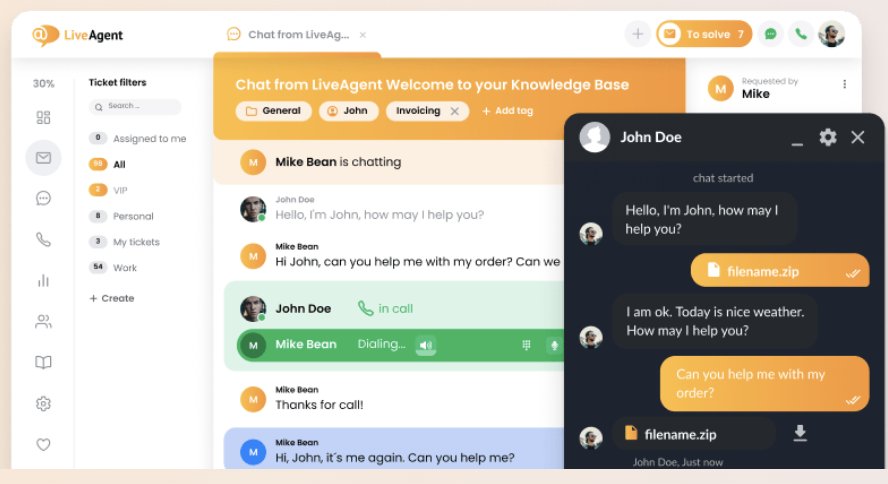
Pros:
- Multi-Channel Support: LiveAgent consolidates queries from email, live chat, social media, and phone into a single interface, making it easier to manage customer interactions.
- Robust Live Chat Functionality: Known for its live chat tool, LiveAgent offers real-time assistance, boosting customer satisfaction and engagement.
- Advanced Ticketing System: It features a powerful ticketing system that can automate and streamline support tasks, improving efficiency.
- Customization and Integration: Offers extensive customization options and integrates well with numerous third-party applications.
- 24/7 Support: LiveAgent provides round-the-clock customer support, ensuring assistance is always available.
Cons:
- Learning Curve: The extensive range of features may require a significant learning curve for new users.
- Pricing: Compared to some competitors, LiveAgent can be more expensive, especially for small businesses or startups.
- Interface Design: Some users find the interface less intuitive and slightly outdated compared to more modern platforms.
Pricing:
LiveAgent offers a tiered pricing structure:
- Free Version: Basic functionalities with limited ticketing features.
- Ticket Plan: Focused on the ticketing system, starting from $15 per agent/month.
- Ticket+Chat Plan: Adds live chat capabilities, starting from $29 per agent/month.
- All-Inclusive Plan: Offers full features, including social media integration, starting from $39 per agent/month.
Is LiveAgent better than Freshdesk?
- Functionality: While Freshdesk is known for its user-friendly interface and strong ticketing system, LiveAgent takes the lead in live chat support and real-time interaction capabilities.
- Integration: Both platforms offer a range of integrations, but LiveAgent’s live chat is more advanced.
- Pricing: Freshdesk may be more affordable for smaller teams, while LiveAgent’s pricing can be higher, particularly for its all-inclusive features.
- Customer Support: Both offer excellent customer support, but LiveAgent’s 24/7 availability is a strong point for businesses requiring constant assistance.
10. Groove
Groove is a customer support platform designed to offer straightforward and efficient service management, particularly suited for small and medium-sized businesses. The software emphasizes a user-friendly ticketing system and an easy-to-navigate interface, aimed at simplifying the customer support process.
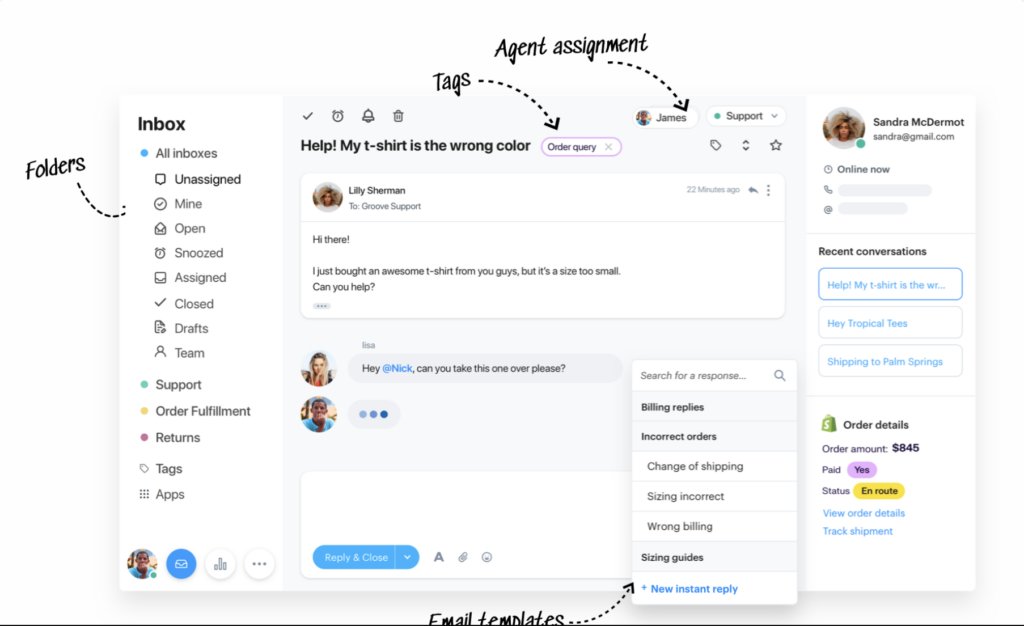
Groove’s core functionality centers around basic ticket management, collaboration tools, and knowledge base creation, providing essential services without the complexity of more advanced systems.
Pros:
- Ease of Use: Groove is highly user-friendly, making it easy for teams to adopt and use without extensive training.
- Simplified Ticketing System: Offers a clean and straightforward ticketing system that is efficient for managing customer queries.
- Collaboration Features: Includes features like private notes and assignments that enhance team collaboration.
- Customizable Knowledge Base: Allows businesses to build a comprehensive and customizable knowledge base for customer self-service.
- Integrations: Supports essential integrations with popular tools and services.
Cons:
- Limited Advanced Features: Compared to more comprehensive platforms, Groove lacks some advanced features like extensive automation and AI capabilities.
- Scalability: While great for small teams, Groove may not be as scalable for larger enterprises with more complex needs.
- Reporting and Analytics: The reporting tools are basic and might not satisfy businesses needing in-depth analytics.
Pricing:
Groove offers a simple pricing structure:
- Starter Plan: Basic features suitable for small teams, priced at $12 per user/month.
- Plus Plan: More advanced features, including reporting and integrations, priced at $20 per user/month.
- Pro Plan: Full access to all features, priced at $35 per user/month.
Is Groove better than Freshdesk?
- User Interface: Groove’s interface is simpler and more intuitive, which is great for smaller teams or businesses new to customer support software, while Freshdesk offers a more feature-rich environment.
- Features: Freshdesk provides a wider range of features, including advanced automation and AI, which Groove lacks.
- Pricing: Groove offers more straightforward and generally lower pricing, which can be a better fit for smaller businesses or those with limited budgets.
- Scalability: Freshdesk is more suitable for larger businesses or those with more complex customer support processes, whereas Groove is ideal for smaller operations.
Why Hiver is the best Groove Alternative
11. Dixa
Dixa, a dynamic cloud-based customer engagement platform, is designed to transform the way businesses interact with their customers. Offering a personalized and more human approach to customer service, Dixa integrates various communication channels like phone, email, chat, and messaging into one seamless platform. Ideal for businesses aiming to enhance customer experiences with efficient and unified communications, Dixa stands out for its innovative approach to customer engagement.
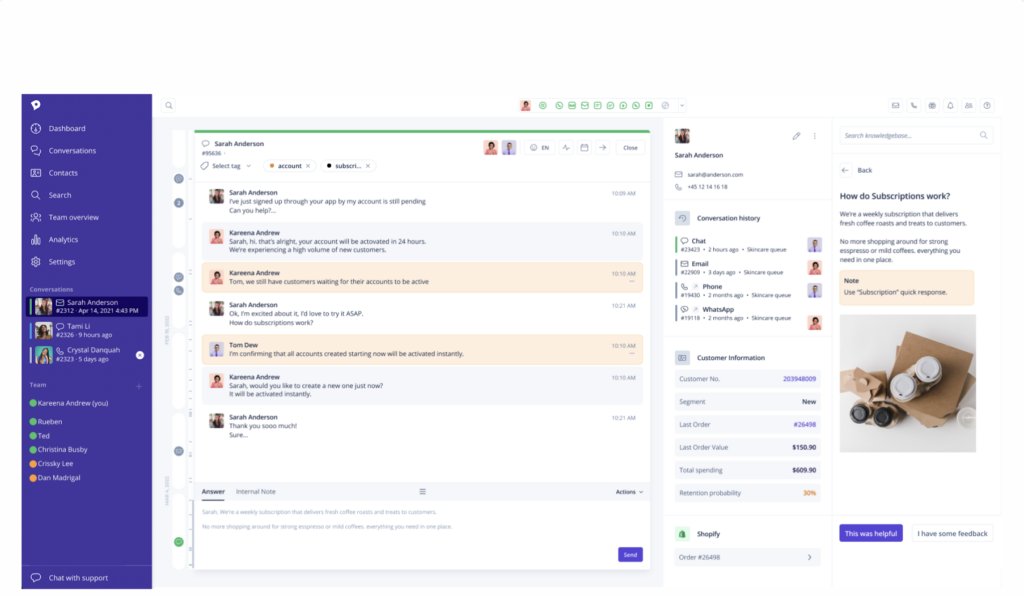
Pros:
- Omnichannel Support: Offers a true omnichannel experience, allowing seamless switching between communication channels within the same conversation.
- Customer Recognition: Advanced customer recognition features enable personalized service.
- Real-time Performance Metrics: Provides real-time insights into support team performance and customer satisfaction.
- Scalability: Well-suited for growing businesses due to its scalable infrastructure.
- Automation and AI: Includes automation tools and AI to streamline workflows and customer interactions.
Cons:
- Complexity: Some users may find the range of features and integrations initially overwhelming.
- Cost: Can be more expensive than some other platforms, especially for smaller businesses.
- Integration Challenges: While offering numerous integrations, some users report difficulties in setting them up or in their functionality.
Pricing:
Dixa’s pricing is structured into several tiers, each catering to different business needs and sizes:
- Essential Plan: This is the starting plan, priced at $39 per agent per month. It is designed to provide the basic service essentials required to engage and build a customer base.
- Growth Plan: Aimed at businesses looking to scale and offer more personalized service, this plan is priced at $89 per agent per month.
- Ultimate Plan: This tier includes advanced automation and Knowledge-Centered Service, aimed at creating lasting customer loyalty. It is priced at $139 per agent per month.
- Custom Plan: Dixa also offers a Custom plan tailored to specific business needs. For this plan, businesses need to contact Dixa for pricing details.
These pricing tiers allow businesses to choose a plan that aligns with their scale of operations and specific customer service requirements, from basic essentials to more advanced and personalized customer engagement strategies.
Comparison with Freshdesk:
- Channel Integration: Dixa’s strength lies in its true omnichannel support dashboard, which is more integrated compared to Freshdesk’s multi-channel approach.
- Customer Interaction: Dixa provides more advanced tools for personalizing customer interactions, while Freshdesk focuses on a broader range of general support tools.
- Pricing Model: Freshdesk has a more straightforward and generally more affordable pricing structure, making it accessible for smaller businesses, whereas Dixa is tailored to the specific needs and tends to be higher in cost.
- Ease of Use: Freshdesk is known for its user-friendly interface, which may be more appealing for businesses looking for simplicity and ease of use, while Dixa offers a more comprehensive set of features but with a steeper learning curve.
Key Features to Look for in a Freshdesk Alternative
Freshdesk, a popular choice, sets a high bar with its range of features and functionalities. However, various reasons may lead a business to explore alternatives. This guide delves into the key features to look for when considering a switch from Freshdesk. By focusing on aspects such as omnichannel support, AI capabilities, customization, analytics, and more, we aim to provide a comprehensive framework to help businesses identify a solution that aligns perfectly with their unique needs and goals.
Omnichannel Support:
- Unified Customer View: Integration of email, chat, social media, and phone for a holistic view of customer interactions.
- Channel Flexibility: Ability to switch between channels seamlessly during customer interactions.
- Customer History Tracking: Maintaining comprehensive customer interaction histories across channels.
- Consistent Service Quality: Ensuring uniform service standards across all channels.
Automation and AI Capabilities:
- Automated Ticket Routing: Directing customer queries to the right agents based on keywords, workload, or customer history.
- AI-Powered Responses: Using AI to suggest or automate responses for common queries.
- Workflow Automation: Streamlining repetitive tasks like follow-ups and notifications.
Customization and Scalability:
- Customizable Dashboards and Reports: Tailoring interfaces and reports to meet specific business needs.
- Workflow Customization: Flexibility to adapt ticket flows and processes.
- Scalable Infrastructure: Ability to handle increased loads and more complex operations.
- Personalization Features: Tools to personalize customer interactions based on their history and preferences.
Analytics and Reporting:
- Performance Metrics: Detailed insights into team performance, response times, and resolution rates.
- Customer Satisfaction Tracking: Tools to measure and analyze customer satisfaction.
- Real-Time Reporting: Access to real-time data for immediate insights and decisions.
Integration with Other Tools:
- CRM Integration: Seamless connection with customer relationship management systems.
- Email and Calendar Integration: Synchronization with company email and calendar systems.
- Social Media Integration: Ability to manage social media interactions within the platform.
- API Access: Robust API support for custom integrations.
User-Friendly Interface:
- Intuitive Design: Easy-to-navigate layout that reduces training time.
- Customizable Views: Ability to tailor views and dashboards to individual preferences.
- Mobile Accessibility: Mobile-friendly design for on-the-go access.
Security and Compliance:
- Data Encryption: Ensuring data is securely encrypted in transit and at rest.
- Compliance Certifications: Adherence to industry standards and regulations.
- Regular Security Updates: Keeping the platform updated with the latest security patches.
- Access Controls: Robust permission settings to control data access.
Customer Support and Community:
- 24/7 Support Availability: Round-the-clock support for urgent issues.
- Training Resources: Access to comprehensive training materials and tutorials.
- Active User Community: A vibrant user community for peer support and knowledge sharing.
- Regular Updates and Communication: Frequent platform updates and clear communication about new features and improvements.
How to Choose the Best Freshdesk Alternative
Choosing the best Freshdesk alternative involves a strategic approach tailored to your business’s specific requirements. Here’s a guide to navigate this process:
Assessing Your Business Needs:
- Identify Key Requirements: Understand the essential features your business needs from a support platform.
- Team’s Skill Level: Consider the technical proficiency of your team to ensure a smooth transition.
- Volume and Complexity of Support Queries: Gauge the volume and nature of your customer interactions.
- Future Growth Plans: Ensure the software can scale with your business growth.
Budget Considerations:
- Total Cost of Ownership: Look beyond just the subscription costs to include training, integrations, and any additional fees.
- Return on Investment: Evaluate how the software can improve efficiency and customer satisfaction.
- Flexible Pricing Plans: Consider if the pricing structure aligns with your business size and growth trajectory.
- Hidden Costs: Be aware of potential hidden costs like add-ons or upgrades.
Ease of Transition:
- Data Migration Capabilities: Ensure the new platform can smoothly import data from Freshdesk or other systems.
- Training and Onboarding Support: Check the availability and quality of training resources and support.
- Downtime Minimization: Plan for a transition that minimizes operational downtime.
Trial and Testing:
- Free Trials or Demos: Use free trials to get a hands-on feel for the software.
- Feature Testing: Test key features to ensure they meet your requirements.
- User Feedback: Gather feedback from your team during the trial period.
Customer Reviews and Feedback:
- Third-party Reviews: Consult independent reviews and ratings for unbiased insights.
- User Testimonials: Look for testimonials or case studies from businesses similar to yours.
- Community and Forums: Explore user communities for honest feedback and tips.
Support and Reliability:
- Quality of Customer Support: Evaluate the responsiveness and effectiveness of the vendor’s customer support.
- Uptime and Reliability Records: Check the platform’s historical uptime and reliability metrics.
- Emergency Support: Consider the availability of support in emergency situations.
Future-Proofing:
- Adaptability to Trends: Ensure the platform keeps up with the latest customer service trends and technologies.
- Regular Updates: Look for a commitment to regular updates and feature enhancements.
- Vendor’s Market Position: Consider the vendor’s stability and position in the market.
- By following these steps, you can thoroughly evaluate and select an alternative to Freshdesk that not only meets your current needs but also supports the long-term success and satisfaction of your customers and team.
10 Things to Consider When Choosing a Customer Service Solution
Upgrade to a better solution
While Freshdesk is a robust and widely-used customer support platform, it’s essential to recognize that one size doesn’t fit all in the dynamic landscape of customer service software. The journey to finding the right alternative involves a thorough assessment of your business’s unique needs, budget constraints, and growth objectives.
By considering factors like specific features, user experience, scalability, integration capabilities, and the quality of customer support, you can make an informed choice that enhances your customer service operations.
Remember, the goal is not just to replace Freshdesk but to upgrade or tailor your customer support system in a way that propels your business forward. This strategic approach ensures you invest in a solution that not only addresses your current challenges but also aligns with your long-term vision for customer engagement and satisfaction.

































